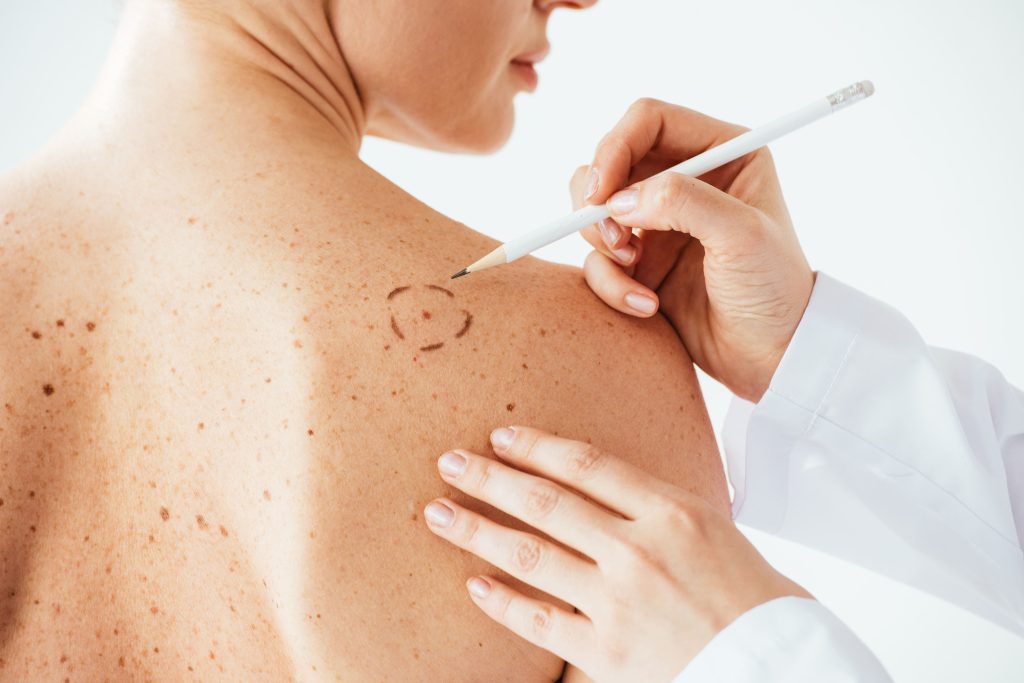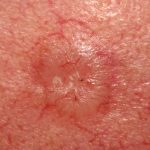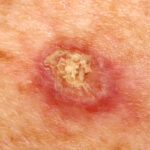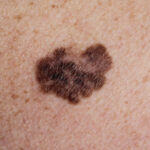Back to General Dermatology

Types of Skin Cancer
- Basal Cell Carcinoma (BCC): BCC is the most common type of skin cancer, accounting for 80-85% of all skin cancers. They most frequently occur on sun-exposed areas, such as the face and
 neck. It typically presents as a raised, pearly bump; pink shiny or scaly spot; or a sore that doesn’t heal. Most basal cell carcinomas grow locally but do not spread to other parts of your body.
neck. It typically presents as a raised, pearly bump; pink shiny or scaly spot; or a sore that doesn’t heal. Most basal cell carcinomas grow locally but do not spread to other parts of your body.
- Squamous Cell Carcinoma (SCC): SCC is the second most common type, accounting for 10-15% of all skin cancers. SCC most frequently occurs in sun-exposed areas.
 SCC typically manifests as a scaly, pink patch, or a raised firm bump that may crust or bleed. While typically locally growing, SCC can spread or metastasize to other parts of the body.
SCC typically manifests as a scaly, pink patch, or a raised firm bump that may crust or bleed. While typically locally growing, SCC can spread or metastasize to other parts of the body.
- Malignant Melanoma: Melanoma is a more aggressive form of skin cancer and develops from melanocytes, or pigment cells in the skin. 20-
 30% of melanomas develop from preexisting moles, and 70-80% develop as new, abnormal growths. Melanomas that are detected early have a 5 year survival rate of 99%. However, without early detection and treatment, melanomas can spread, or metastasize. It is estimated that close to 8000 Americans will die from melanoma in 2023.
30% of melanomas develop from preexisting moles, and 70-80% develop as new, abnormal growths. Melanomas that are detected early have a 5 year survival rate of 99%. However, without early detection and treatment, melanomas can spread, or metastasize. It is estimated that close to 8000 Americans will die from melanoma in 2023.
Prevention of Skin Cancer
- Sun Protection: Limit your sun exposure, especially during peak hours (7am to 7pm in sunny Arizona!). Physical sun protective measures, such as hats, sunglasses, and clothing that covers the skin, can reduce UV exposure.
- Sunscreen: Regularly apply broad-spectrum sunscreen with a sun protection factor (SPF) of 30-50 to sun exposed areas. A shot glass of sunscreen is required to adequately protect most bodies while wearing a swimsuit. Sunscreen must be reapplied at least every two hours to maintain effectiveness. More frequent reapplication is required if sweating or swimming.
- Seek Shade: Taking breaks in shaded areas or using umbrellas or canopies when outdoors can provide additional protection from the sun’s harmful rays.
- Avoid Tanning Beds: Artificial UV radiation from tanning beds is a known risk factor for skin cancer and should be avoided altogether. Using tanning beds one time before the age of 35 increases the risk of melanoma by 75%.
Early Detection and Self-Examinations
- Self-Examinations: Performing regular self-examinations of the skin can help detect any suspicious moles or lesions. The ABCDE rule (Asymmetry, Border irregularity, Color variation, Diameter larger than 6mm, Evolving) is a helpful guideline to identify potential signs of melanoma.
- Professional Skin Examinations: Regular visits to a dermatologist for professional skin examinations are essential, particularly for individuals at higher risk or with a history of skin cancer. Dermatologists can identify and evaluate any suspicious skin lesions and provide appropriate guidance and treatment.
Treatment Options for Skin Cancer
- Surgical Excision: Surgical removal is a common treatment for skin cancers, involving the removal of the cancerous tissue along with a margin of healthy skin.
- Mohs Surgery: Mohs micrographic surgery is a specialized technique used for skin cancers occurring in cosmetically sensitive areas and for larger, recurrent, high-risk skin cancers. This technique ensures the highest level of accuracy while minimizing the removal of healthy tissue. Mohs micrographic surgery has a 98-99% cure rate for most primary non melanoma skin cancer.
- Radiation Therapy: Radiation therapy may be used in cases where surgery is not feasible or to target cancer cells that have spread.
- Topical Medications: For certain superficial skin cancers, topical medications such as imiquimod or fluorouracil cream may be prescribed to destroy cancer cells.
- Immunotherapy and Targeted Therapy: In advanced cases of non melanoma skin cancer or metastatic melanoma, newer treatment options like immunotherapy or targeted therapy may be recommended.
Skin cancer is a significant health concern. However with proper prevention strategies, early detection, and prompt treatment, the prognosis can be favorable. Regular sun protection, self-examinations, and professional skin evaluations are crucial for identifying skin cancer at its early stages. If you notice any suspicious moles or lesions or have concerns about your skin, we highly encourage you to call and schedule a skin check with one of our highly skilled board-certified medical providers for a thorough evaluation and appropriate management.

 neck. It typically presents as a raised, pearly bump; pink shiny or scaly spot; or a sore that doesn’t heal. Most basal cell carcinomas grow locally but do not spread to other parts of your body.
neck. It typically presents as a raised, pearly bump; pink shiny or scaly spot; or a sore that doesn’t heal. Most basal cell carcinomas grow locally but do not spread to other parts of your body. SCC typically manifests as a scaly, pink patch, or a raised firm bump that may crust or bleed. While typically locally growing, SCC can spread or metastasize to other parts of the body.
SCC typically manifests as a scaly, pink patch, or a raised firm bump that may crust or bleed. While typically locally growing, SCC can spread or metastasize to other parts of the body. 30% of melanomas develop from preexisting moles, and 70-80% develop as new, abnormal growths. Melanomas that are detected early have a 5 year survival rate of 99%. However, without early detection and treatment, melanomas can spread, or metastasize. It is estimated that close to 8000 Americans will die from melanoma in 2023.
30% of melanomas develop from preexisting moles, and 70-80% develop as new, abnormal growths. Melanomas that are detected early have a 5 year survival rate of 99%. However, without early detection and treatment, melanomas can spread, or metastasize. It is estimated that close to 8000 Americans will die from melanoma in 2023.